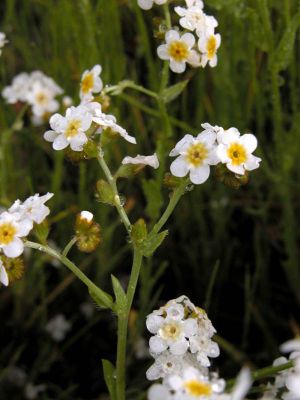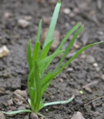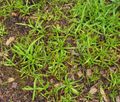Difference between revisions of "Plagiobothrys figuratus"
From Puget Prairie Plants
(→Photo Gallery) (Tag: VisualEditor) |
(→Photo Gallery) (Tag: VisualEditor) |
||
| Line 23: | Line 23: | ||
==Description== | ==Description== | ||
| − | + | Annual with short hairs, simple or few-branched stems. | |
| − | + | Linear, all-cauline, lower pairs opposite, becoming alternate up the stem. | |
| − | + | Inflorescence consists of naked spikes, tending to be paired, calyx has yellowish, loose hairs. Flowers fragrant, corolla white with a yellow eye; corolla tube narrow, the 5 lobes abruptly spreading. | |
| − | + | Fruits are 4 keeled, rough, ovate nutlets 1.2-1.7 mm. long.<ref name=":0">WTU Herbarium, Burke Museum, | |
| + | & University of Washington. Retrieved from <nowiki>https://biology.burke.washington.edu/herbarium/imagecollection/taxon.php?Taxon=Plagiobothrys%20figuratus</nowiki></ref><ref name=":1">Hitchcock, C. L., Cronquist, A., Giblin, D., & Legler, | ||
| + | B. et al. (2018). ''Flora of the Pacific Northwest: an illustrated manual''. | ||
| + | Seattle: University of Washington Press.</ref> | ||
==Bloom Period== | ==Bloom Period== | ||
| − | May-July | + | May-July<ref name=":0" /> |
==Distribution== | ==Distribution== | ||
| − | + | Victoria Island and Thurston County, south, chiefly west of the Cascades and Willamette Valley, but also in Columbia River Gorge, to Southwest Oregon.<ref name=":1" /> | |
| − | + | ||
==Habitat== | ==Habitat== | ||
| − | + | Nonalkaline meadows, low ground, and moist fields.<ref name=":1" /> | |
| − | + | ||
| − | + | ||
| − | + | ||
==Photo Gallery== | ==Photo Gallery== | ||
<gallery> | <gallery> | ||
File:PLFI_BenLegler_flw_avg.jpg|Photo by Ben Legler | File:PLFI_BenLegler_flw_avg.jpg|Photo by Ben Legler | ||
| − | File: | + | File:PLAFIG3.png| Young growth, courtesy of CNLM |
| − | File: | + | File:PLAFIG2.jpg|Young growth, courtesy of CNLM |
File:PLFI_LisaHintz_sd_2012.jpg| seed, photo by Lisa Hintz | File:PLFI_LisaHintz_sd_2012.jpg| seed, photo by Lisa Hintz | ||
</gallery> | </gallery> | ||
==References== | ==References== | ||
Revision as of 19:31, 2 June 2020
- Latin Name: Plagiobothrys figuratus
- Family: Boraginaceae
- Common Names: fragrant plagiobothrys
- Synonyms/Misapplications: Allocarya figurata
- CODON: PLAFIG
Contents
Taxonomy
| Plagiobothrys scouleri | |
|---|---|

| |
| Photo: Ben Legler 2004 | |
| Scientific classification | |
| Kingdom: | Plantae |
| Subkingdom: | Tracheobionta |
| Phylum: | Spermatophyta |
| Subphylum: | Magnoliophyta |
| Class: | Magnoliopsida |
| Subclass: | Asteranae |
| Order: | Boraginales |
| Family: | Boraginaceae |
| Genus: | Plagiobothrys Fisch. & C.A. Mey. |
| Species: | Plagiobothrys figuratus I.M. Johnst. ex. M. Peck |
Description
Annual with short hairs, simple or few-branched stems.
Linear, all-cauline, lower pairs opposite, becoming alternate up the stem.
Inflorescence consists of naked spikes, tending to be paired, calyx has yellowish, loose hairs. Flowers fragrant, corolla white with a yellow eye; corolla tube narrow, the 5 lobes abruptly spreading.
Fruits are 4 keeled, rough, ovate nutlets 1.2-1.7 mm. long.[1][2]
Bloom Period
May-July[1]
Distribution
Victoria Island and Thurston County, south, chiefly west of the Cascades and Willamette Valley, but also in Columbia River Gorge, to Southwest Oregon.[2]
Habitat
Nonalkaline meadows, low ground, and moist fields.[2]
Photo Gallery
References
- ↑ 1.0 1.1 WTU Herbarium, Burke Museum, & University of Washington. Retrieved from https://biology.burke.washington.edu/herbarium/imagecollection/taxon.php?Taxon=Plagiobothrys%20figuratus
- ↑ 2.0 2.1 2.2 Hitchcock, C. L., Cronquist, A., Giblin, D., & Legler, B. et al. (2018). Flora of the Pacific Northwest: an illustrated manual. Seattle: University of Washington Press.




